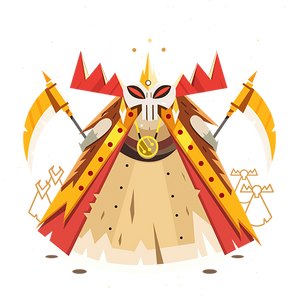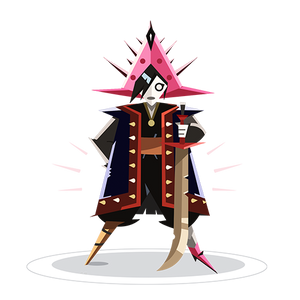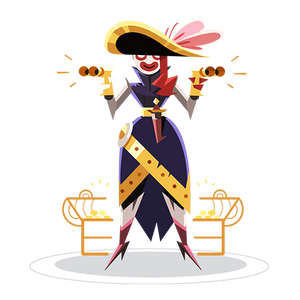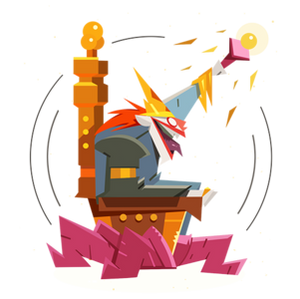Drawing Mechanics
In a card game, the algorithm that determines how cards are drawn is extremely important. Take a physical card game as an example: if after playing a card, it goes at the bottom of the deck, then it implies all cards need to be played before a given card can be played again. If on the other hand, the deck is shuffled after playing a card, that changes the strategy quite a bit.
Stormbound uses something called a “weighted random”. That means each card in a deck is assigned a certain weight which determines its chances of being drawn. In such a system, the higher a card’s weight, the higher the chance it gets drawn.
You can experiment with all the mechanics mentioned in this guide directly within the deck dry-runner. Simply open or compose a deck in the deck builder, then click “Practice” in the navigation to start.
Initial hand
At the beginning of a match, an initial routine assigns a weight to all cards in the deck in a random way. The logic to do so goes more or less like this:
- The deck is initially shuffled. This is to make sure the weights do not match the card order (lowest weight on cheaper cards, and higher weights on more expensive ones).
- The first card of the shuffled deck is assigned a weight of 1.
- Every card is then assigned a weight based on the weight of the previous card following the formula: weight × 1.6 + 100. As a result, the second card has a weight of 101.6 (1 × 1.6 + 100) and the third card of 262.56 (101.6 × 1.6 + 100) and so on and so forth.
- From there, 4 cards are drawn with the weighted random to compose the initial hand. That means the cards with the highest weights are most likely to be drawn, but that’s not a guarantee.

Drawing and playing
There are two main concepts to the hand manipulation: drawing and playing. Cycling is just a combination of both where a card is “played” into the deck (also known as “discarded”) and followed by a card draw.
When a card is drawn, its weight is reset to 1. When a card is played, all the other cards from the deck (not from the hand) see their weight increase following the initial formula: current weight × 1.6 + 100. As an example, a card with a weight of 12 would end up with a weight of 119. This is what is called a “reweighing of the deck”.
Queen of Herds
Queen of Herds has such an awkward and undisclosed mechanic that it deserves having a closer look at how exactly it works.

On play, randomly play up to 1 non‑Hero Satyrs with strength set to 2 from your deck on a tile in its row

On play, randomly play up to 1 non‑Hero Satyrs with strength set to 3 from your deck on a tile in its row

On play, randomly play up to 1 non‑Hero Satyrs with strength set to 4 from your deck on a tile in its row

On play, randomly play up to 2 non‑Hero Satyrs with strength set to 4 from your deck on a tile in its row

On play, randomly play up to 2 non‑Hero Satyrs with strength set to 5 from your deck on a tile in its row
First of all, Queen of Herds does not respect the cards weight when drawing satyrs from the deck. It uses a purely random draw (or two in case of levels 4 and 5). That implies playing, say, Dreadfauns, then playing Queen of Herds, does not prevent Dreadfauns from being drawn again even though there are other satyrs in the deck. It is definitely possible.
Additionally, the cards played by Queen of Herds do not cause a reweighing of the deck. This means a card played for free by Queen of Herds preserves its current weight. If it was high to begin with, it stays high and the card is likely to come back in hand shortly.
Pirates
Most pirate cards rely on drawing and cycling mechanics. Unlike Queen of Herds however, they behave as one would expect, just like normal drawing, playing and cycling although there remains some (low-impacting) unknowns.

On play, discard a random non‑Pirate card from your hand

On play, draw 1 card

On play, replace 1 random non‑Pirate card from your hand

When played with a full hand, discard all cards and draw 4 new cards
- First Mutineer discards a non-pirate card from the hand and into the deck. Playing the card itself causes a reweighing, and it is assumed (although not confirmed) that the discarded card causes another reweighing as well.
- Freebooters draws one or two cards (depending on level) following the usual weighted random. A reweighing of the deck occurs when playing the card itself, like for any other play.
- Goldgrubbers discards a non-pirate card from the hand and into the deck, then draws a card following the usual weighted random. This works similarly to First Mutineer and Freebooters.
- Snake Eyes—provided it is played as first card of a turn—discards the remaining hand and draws 3 or 4 cards following the usual weighted random, causing at least 1 reweighing of the deck. It is unclear whether all 3 cards are discarded at once or sequentially, although the difference should be relatively minor (2 reweighing instead of 4).
Other edge cases
Finally, let’s have a look at a few last cards with mechanics impacting none of which has particularly odd resolution.

When played with no surrounding units, return this card back to your hand with 1 more strength

On play, randomly play up to 2 spell cards from your hand, each costing 6 or less and up to 8 combined mana cost

On play, create a 0 cost unit with 5 strength and add it to your deck
Counselor Ahmi—which oddly has a pirate-like ability despite being in Swarm of the East—is working as one would expect.
When played with no bordering enemies, it comes back in the hand immediately. Playing the card causes a reweighing of the deck as normal and Counselor Ahmi comes back to the hand despite its weight being 1. This is likely implemented by a “forced-draw” mechanism.
Temple of Space works in a very similar fashion. When played without an active copy on the board, it comes back to the hand despite its weight being 1.
Archdruid Earyn simply plays one or two spells from the hand (provided they do not cost more than Earyn’s mana cost). Unlike with Queen of Herds, these plays do cause a reweighing of the deck (or 2 for level 4 and 5). Interestingly enough, the first spell played by Archdruid Earyn will end up with a non-1 weight after the second spell is played, which mean it could technically be drawn (although unlikely) right away.
Finally Collector Mirz (and Harvesters of Souls) simply add a card to the deck with a weight of 1, without causing an extra reweighing of the deck. Only the regular reweighing due to card play occurs. However, cards generated by Guardi the Lightbringer have their own (unknown) drawing algorithm intended to boost Guardi’s ability.
Strategy
Stormbound being a game where the player making the most of their mana is likely the one to win, it is usually advised to cycle at every turn. The idea is that you want to cycle through your deck rapidly so you can play your main cards and combos more frequently. The more you cycle, the faster you can go through all the cards of your deck.
Whether you should cycle before or after your play(s) varies. Cycling before is preferable because it gives all the information first hand to play the best turn possible. When playing Collector Mirz however, you might want to discard after having played it so the deck gets reweighed with the new token card in it, speeding up its first apparition in your hand.
When it comes to combos (cards that need to be played together to excel), it is recommended not to “break them”. Imagine you have both Frosthexers and Icicle Burst in your hand, but there are no enemies to freeze with Frosthexers. If you end up playing or cycling one but not the other, their weights are going to be desynchronised, which reduces the likelihood of having them together shortly. In such case, it would be wise to cycle Icicle Burst and play Frosthexers so that both cards end up back in the deck with a weight of 1.
You can try all these mechanics and practice your mana curve in the deck dry-runner. Simply open or compose a deck in the deck builder, then click “Practice” in the navigation to start.